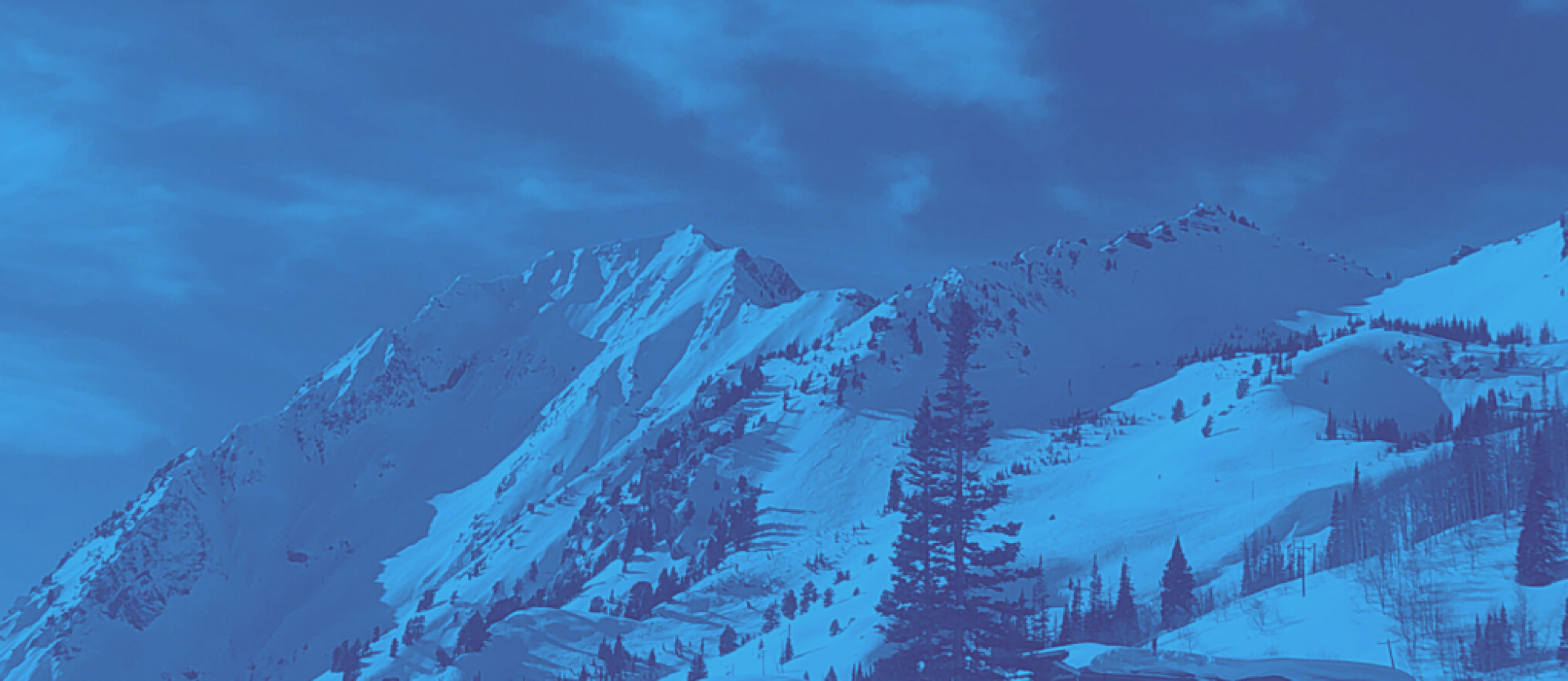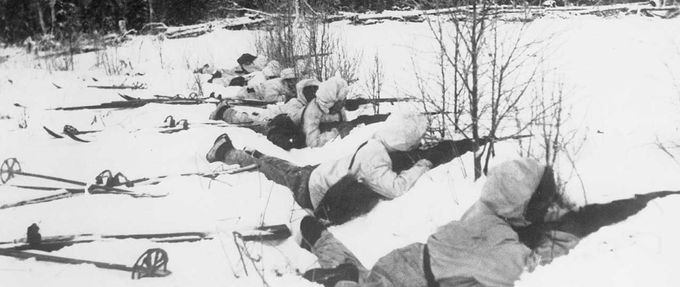
Public Domain, Image Credit: http://media.iwm.org.uk/iwm/mediaLib//31/media-31414/large.jpg
For most, the first picture that comes to mind when imagining skiing is gliding down the smooth slopes of a resort, only to be followed by an overpriced hot chocolate at the base of the mountain. This is no accident, as skiing has long been advertised, both in the United States and abroad, as an almost fantastical winter wonderland activity. Ski resorts are destinations for tourists to come to be with nature, and for many that is the only image of skiing they’ve ever known. While this is certainly a well-crafted portrayal of the ski industry, many are surprised to learn that skiing has been used for centuries, not just as a leisure or athletic activity, but as a highly effective means of warfare.
There is perhaps no better example of the advantage an army can gain from the use of ski warfare than the Winter War, fought between the Soviet Union and Finland (1939-1940). This war consisted of a badly outnumbered and substantially less mechanized Finnish army battling the Soviet Union’s infamous Red Army, in what can only be described as a David and Goliath-like conflict. Only through the exploitation of Finland’s unique geography and the enhanced mobility gained from their army’s near-ubiquitous mastery of skiing was the Finnish Army able to successfully carry out a crippling guerilla warfare campaign. To properly understand the role that both ski units and the landscape played in this conflict each of their histories should be examined.
While the true date may be earlier, given skiing’s some 8,000-year history, the first documented use of ski troops dates as far back as the thirteenth century. According to The Culture and Sport of Skiing, during that time the militaries of Norway and other Scandinavian countries equipped many of their reconnaissance troops with skis to afford them greater speed in the snowy terrain. It wasn’t until the First World War that skis would reappear in military ranks. The Italian army, in preparation for war in the Alps mountain range, created a number of mountain infantry battalions called the Alpini, some of which were specifically trained in skiing. The Alpini found great initial success, but, as with the increased stagnation of trench warfare across Europe, they too found themselves locked in stalemates, greatly reducing their effectiveness. However, in the years following the war, specifically in the Winter War, ski troops would truly have the opportunity to demonstrate their capabilities as an effective and deadly combat force due to the change in the strategic approach to warfare and new terrain.
During the Interwar Period, there were several considerable advancements, namely the widespread development of armored vehicles and aircraft. These advancements in warfare allowed for the new approach often called the Blitzkrieg. This approach utilized highly mobile troops that would strike swift offensive blows at enemy forces. The abandonment of the entrenched form of warfare and implementation of the Blitzkrieg proved highly successful throughout Europe; however, it also contributed to the ski troops of the Finnish Army being so successful against the Soviet invasion.
Over the centuries, skiing, specifically cross-country skiing, has been an important part of the Finnish people’s lives. Unlike its neighbors Sweden and Norway, Finland is mostly lowlands, which led to cross-country skiing becoming more than just a fun activity, but an important means of transportation during the long winters the country experiences. According to a report in the Journal of Travel Research, today ninety-eight percent of Finland still knows how to cross-country ski. The Finnish military has incorporated skiing as an integral part of its basic survival training for so long that the creation of the first biathlon-like competition is credited to them in 1767. While it’s safe to say the Finnish Army was unmatched in ski capabilities, the same cannot be said for the rest of their military strength.
As previously mentioned, the Soviet Union’s Red Army was the far larger and more developed army, particularly considering the Finnish population was roughly four million to the USSR’s 170 million. After the complete mobilization of Finnish troops, their army numbered roughly 300,000 soldiers to the Soviet’s 5,000,000, of which at least several hundred thousand were deployed against Finland. In most battles, the Soviets enjoyed a two-to-one troop advantage, and a startlingly higher tank and aircraft advantage. Finnish historians have estimated that the Finnish forces had no more than 32 active tanks and 114 aircraft, compared to the Red Army’s thousands of both tanks and aircraft at their disposal. While the Finnish forces were at an obvious extreme numerical and material disadvantage, they weaponized many of their “home field” advantages, such as their mastery of skiing and the geographical composition of the battlefields.
The focal point of the conflict was the Karelian Isthmus, the geography of which would greatly determine the fate of the war. Greatly shaped by late-stage deglaciation, by the 1940s the isthmus would become an environment of densely forested long winding hills and numerous lakes. There were very few major roads cutting through the landscape, leaving the vast majority of it as a low altitude evergreen woodland. Furthermore, the war itself lasted just one hundred and five days but took place entirely in winter, one of the coldest winters on record that reached temperatures as low as −45 °F. This fierce cold added further advantages, as the lakes were almost entirely frozen over, and the roads themselves that during springtime might have been easily navigated became all the more treacherous. Such conditions set in place the ideal environment for the ski-powered guerilla campaign that the Finnish Army would employ.
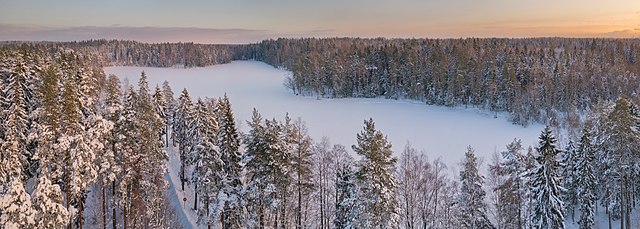
Photographer: Simo Räsänen, Public Domain
The Soviet’s highly mechanized army was forced to use these roads as they were unable to navigate the snow-filled forests. This, coupled with the Soviet’s attempt at a blitzkrieg strategy to end the war quickly, allowed for the use of ski troops to be highly effective. Finnish troops equipped with their cross-country skis, as well as being dressed in all white camouflage so as to blend in with the snowy background, moved through the forest with near invisibility. The hills of the Karelian Isthmus were tall enough, as high as 500ft, to provide sufficient cover for ski troop movements, but not so tall as to completely impede their operations. In his article, “Winter War: The 1939 Soviet Invasion Of Finland In Crystal-Clear Photos,” Amos Chapple noted that to maintain the element of stealth, the Finnish Army went as far as to make “extensive use of reindeer that enabled the fighters to slide machine guns and mortars through the forests in near silence.”
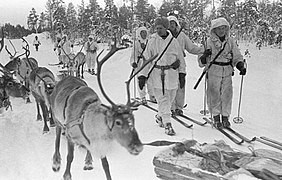
Image Credit: Wikimedia Commons
In comparison, the Soviet troop column could be heard from miles away. The Finnish Army’s superior maneuverability on skis allowed them to navigate the forests of the Isthmus unseen up until the actual surprise attack on the enemy troop columns to devastating effect. While lacking the means of production to arm their troops with anti-tank weapons, the Finnish troops would use inventive new means of disabling the Soviet armored vehicles. This included jamming the enemy tanks’ wheels with items such as crowbars to immobilize them, as well as the far more effective Molotov cocktail, used to destroy dozens of tanks throughout the war. The skirmishes would be over in minutes, long before help from either end of the column could come to their aid.
Due to the lack of substantial infrastructure or major fortifications on the isthmus, the Soviets were forced to create long ineffective supply lines that despite still having a numerical superiority, were often cut or derailed. The Finnish forces would then often move to surround areas of concentrated Soviet troops after they had made an offensive. Additionally, the option of retreating after such an offensive was usually denied to them, as they could be easily pursued by ski troops.
While the story of David and Goliath ends with David as the victor, the same cannot be said for Finland. After the failed first offensive, the Red Army would regroup and dedicate even more soldiers and materials to the war effort, eventually overcoming Finnish defenses. With that being said, most historians see this as at least a partial defeat for the Soviet Union. The war ended with Finland’s independence intact, albeit with a loss of roughly 10% of its territory. Moreover, the casualties inflicted upon the Soviet Union were catastrophic, with some estimations as high as 125,000 deaths for the Red Army, tens of thousands of further causalities, and the destruction of hundreds of aircraft and thousands of armored vehicles. Therefore, while ultimately “losing” the Winter War, Finland’s ability to weaponize their expert use of skiing to take advantage of the terrain of the Karelian Isthmus allowed them to inflict incredible losses on a more powerful enemy.
As the world has experienced a relative period of peace since the Second World War, armed military conflict, particularly in areas that might’ve utilized ski troops, largely ceased.
Unfortunately for us all, one such area has re-entered the minds of many nations as the world descends back into a state where violent conquest is seemingly permitted once more. One such “hot spot” may come at one of Earth’s coldest locations, the Arctic Circle. As the effects of man-made climate change are felt perhaps no more severely than the arctic ice caps, an estimated $35 trillion dollars’ worth of natural resources that were previously written off as unreachable, have now been exposed. Thus, several countries have greatly increased their Arctic military presence, such as the United States and China. However, no country has established more of a military stronghold in the Arctic than Russia, in which over half of the Arctic Ocean’s coastline resides. This new theater of importance has its own unique geography but, in many ways, shares similarities with the battlefields of the Winter War.
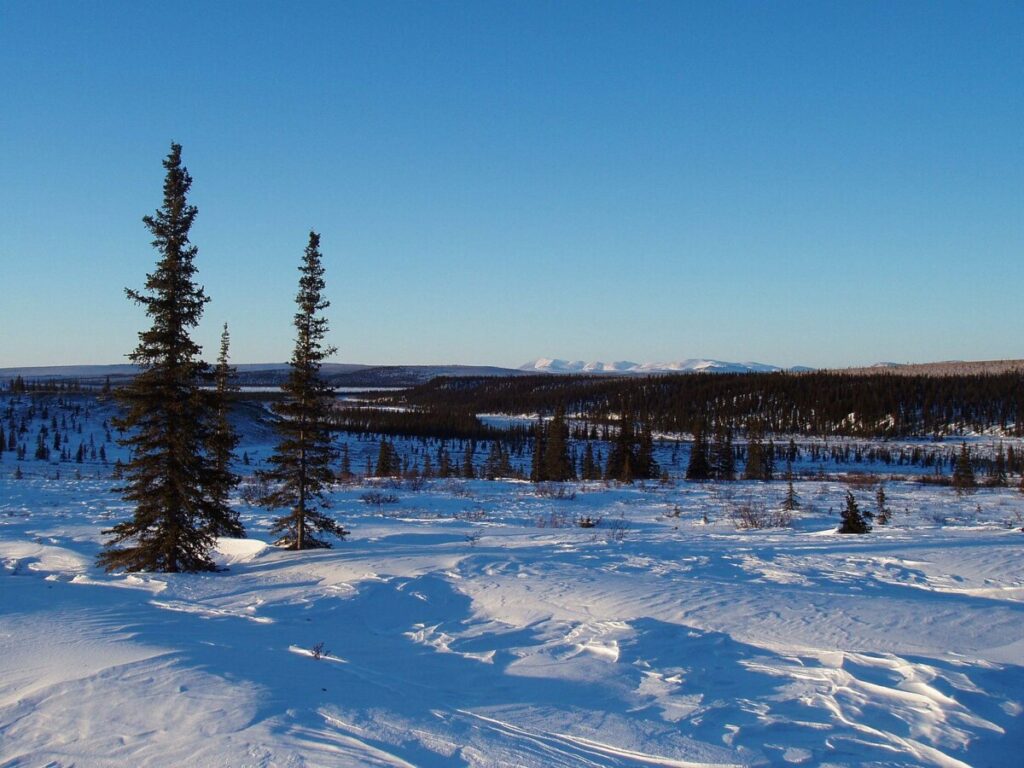
Public Domain, Image Source: Western Arctic National Parklands
The Arctic’s geography is largely one of two types, the mountainous regions on the periphery, and the lowlands ranging from densely forested to entirely barren. While both can make use of ski troops, the latter of the two offers the most similarities to the Karelian Isthmus. The vast miles of ice and snow, comprised mostly of plains that make up the arctic pose a mobility challenge to even our modern militaries. The landscape is by and large flat, with occasional periods of elevation and many shallow lakes that are typically frozen in the winter months, much like the Karelian Isthmus. Such an environment has already proven to be an effective theater for the use of ski troops.
The threat of conflict in this region, particularly with newly revitalized Russia belligerence on the edges of their territory, has never been higher and one determining factor would certainly be the mobility of an army’s troops. In recent years, the Chinese and Russian militaries have run joint winter warfare training operations, while the United States has conducted similar operations with their NATO allies. Naturally, the best outcome would be if there was no conflict to gain an operational edge in the Arctic, however, should that need arise the aforementioned image of skiing being just a winter wonderland activity may soon fade away, with a much more lethal one taking its place.
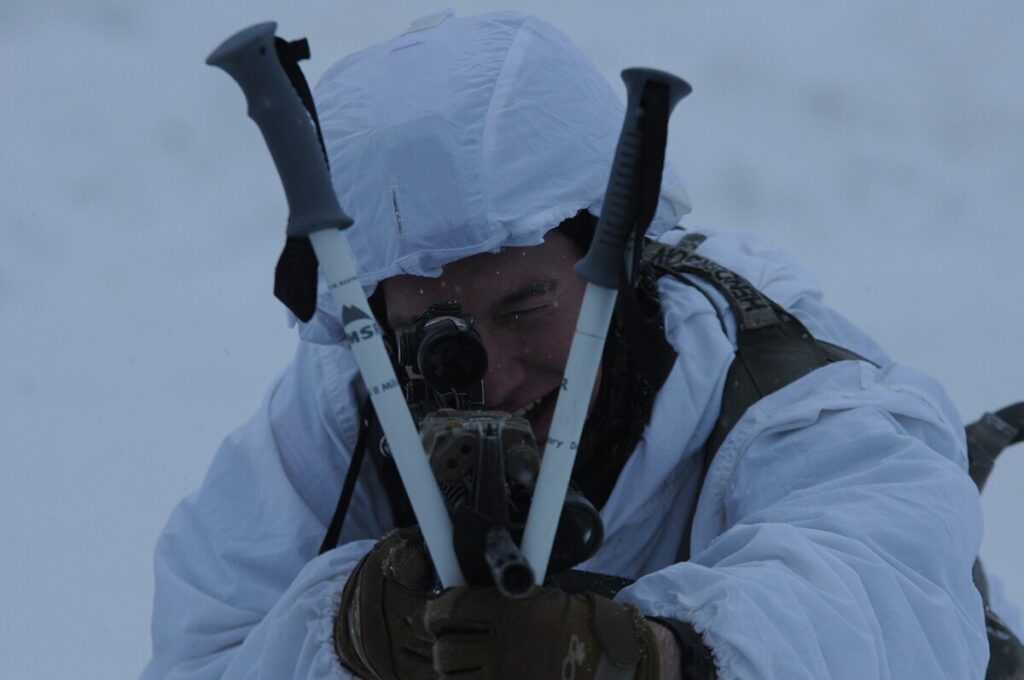
Image Credit: https://www.dvidshub.net/image/1118870/spartan-paratroopers-jump-arctic-gear
Bibliography:
Allen, E. John B. The Culture and Sport of Skiing: From Antiquity to World War II. University of Massachusetts Press, 2007
Chapple, A. (2019, December 2). Winter War: The 1939 Soviet Invasion of Finland in crystal-clear photos. RadioFreeEurope/RadioLiberty. https://www.rferl.org/a/finlands-winter-war-with-the-soviet-union/30280490.html
Citino, R. (2018, June 21). White Death: The National WWII Museum: New Orleans. The National WWII Museum | New Orleans. https://www.nationalww2museum.org/war/articles/white-death.
Ellyatt, H. (2019, December 27). Russia is dominating the Arctic, but it’s not looking to fight over it. CNBC. Retrieved February 18, 2022, from https://www.cnbc.com/2019/12/27/russias-dominance-in-the-arctic.html
Evald Laasi, Tallinn. “Finland’s Winter War and Estonian Neutrality.” Journal of Baltic Studies Vol. 24, No. 3 (1993) 269-282
Isachenko, G. A. (2004). The Landscape of the Karelian Isthmus and its Imagery since 1944. Fennia – International Journal of Geography, 182(1), 47–59. Retrieved from https://fennia.journal.fi/article/view/3747
Kilin, Yuri. The Little War Giant of the Winter War (Talvisodan pikkujättiläinen). WSOY 1999
Lähteenmäki, Ilkka & Virta, Tatu. “The Finnish Twitter war: the Winter War experienced through the #sota39 project and its implications for historiography.” The Journal of Theory and Practice Vol. 20 (2016) 433-453
Landauer, M., Haider, W., & Pröbstl, U. “The influence of culture on climate change adaptation strategies: Preferences of cross-country skiers in Austria and Finland.” Journal of Travel Research 53(1) (2014), pp. 95-109
Landauer, M., Sievänen, T., & Neuvonen, M. “Indicators of climate change vulnerability for winter recreation activities: a case of cross-country skiing in Finland” Leisure/Loisir, 39:3-4, 403-440.
Manninen, Ohto. Hidden background of the Winter War (Talvisodan salatut taustat). Kirjaneuvos 1994
National Geographic Society. (2012, October 9). Arctic. National Geographic Society. Retrieved March 12, 2022, from https://www.nationalgeographic.org/encyclopedia/arctic/
Nicolle, David. The Italian Army of World War I. Osprey Publishing, 2003
Reilly, Henry J. “Blitzkrieg.” Foreign Affairs 18, no. 2 (1940): 254-65.
Rodway, George W. “The White Death.” Wilderness & Environmental Medicine, 23, 275–280 (2012)
Rehman, I. (2016, July 19). Lessons from the WINTER war: Frozen grit and Finland’s Fabian defense. War on the Rocks. https://warontherocks.com/2016/07/lessons-from-the-winter-war-frozen-grit-and-finlands-fabian-defense/.
Trotter, William R. A Frozen Hell: The Russo-Finnish Winter War of 1939-1940. Algonquin Books of Chapel Hill, 2000
Walsh, N. P. (2021, April 5). Satellite images show huge Russian military buildup in the Arctic. CNN. Retrieved March 14, 2022, from https://www.cnn.com/2021/04/05/europe/russia-arctic-nato-military-intl-cmd/index.html
